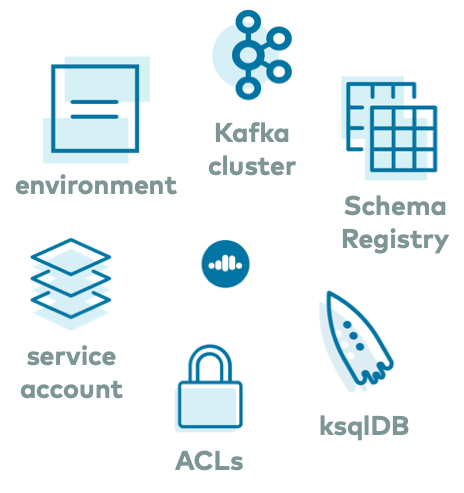Important
You are viewing documentation for an older version of Confluent Platform. For the latest, click here.
ccloud-stack Utility for Confluent Cloud¶
Overview¶
This ccloud-stack utility creates a stack of fully managed services in Confluent Cloud.
It is a quick way to create fully managed resources in Confluent Cloud, which you can then use for learning and building other demos.
The utility uses Confluent Cloud CLI under the hood to dynamically do the following in Confluent Cloud :
- Create a new environment
- Create a new service account
- Create a new Kafka cluster and associated credentials
- Enable Schema Registry and associated credentials
- Create a new ksqlDB app and associated credentials
- Create ACLs with wildcard for the service account

In addition to creating these resources, ccloud-stack also generates a local configuration file with connection information to all of the above services.
This file is particularly useful because it contains connection information to your Confluent Cloud instance, and any downstream application or Kafka client can use it, or you can use it for other demos or automation workflows.
Confluent Cloud Promo Code¶
The first 20 users to sign up for Confluent Cloud and use promo code C50INTEG will receive an additional $50 free usage (details).
Caution¶
This utility uses real Confluent Cloud resources. To avoid unexpected charges, carefully evaluate the cost of resources before launching the utility and ensure all resources are destroyed after you are done running it.
Prerequisites¶
- Create a user account in Confluent Cloud
- Local install of Confluent Cloud CLI v1.13.0 or later.
jqtool
Usage¶
Setup¶
Clone the confluentinc/examples GitHub repository and check out the
5.5.15-postbranch.git clone https://github.com/confluentinc/examples cd examples git checkout 5.5.15-post
Change directory to the ccloud-stack utility:
cd ccloud/ccloud-stack/
Log in to Confluent Cloud with the command
ccloud login, and use your Confluent Cloud username and password. The--saveargument saves your Confluent Cloud user login credentials or refresh token (in the case of SSO) to the localnetrcfile.ccloud login --save
Create a ccloud-stack¶
By default, the
cloud-stackutility creates resources in the cloud providerawsin regionus-west-2. If this is the target provider and region, create the stack by calling the bash script ccloud_stack_create.sh. For more options when configuring yourccloud-stack, see Advanced Options../ccloud_stack_create.sh
In addition to creating all the resources in Confluent Cloud with associated service account and ACLs, running
ccloud-stackalso generates a local configuration file with all the Confluent Cloud connection information, which is useful for other demos/automation. View this file atstack-configs/java-service-account-<SERVICE_ACCOUNT_ID>.config. It resembles:# ------------------------------ # ENVIRONMENT ID: <ENVIRONMENT ID> # SERVICE ACCOUNT ID: <SERVICE ACCOUNT ID> # KAFKA CLUSTER ID: <KAFKA CLUSTER ID> # SCHEMA REGISTRY CLUSTER ID: <SCHEMA REGISTRY CLUSTER ID> # KSQLDB APP ID: <KSQLDB APP ID> # ------------------------------ ssl.endpoint.identification.algorithm=https security.protocol=SASL_SSL sasl.mechanism=PLAIN bootstrap.servers=<BROKER ENDPOINT> sasl.jaas.config=org.apache.kafka.common.security.plain.PlainLoginModule required username\="<API KEY>" password\="<API SECRET>"; basic.auth.credentials.source=USER_INFO schema.registry.basic.auth.user.info=<SR API KEY>:<SR API SECRET> schema.registry.url=https://<SR ENDPOINT> ksql.endpoint=<KSQLDB ENDPOINT> ksql.basic.auth.user.info=<KSQLDB API KEY>:<KSQLDB API SECRET>
Destroy a ccloud-stack¶
To destroy a
cloud-stackcreated in the previous step, call the bash script ccloud_stack_destroy.sh and pass in the client properties file auto-generated in the step above../ccloud_stack_destroy.sh stack-configs/java-service-account-<SERVICE_ACCOUNT_ID>.config
Advanced Options¶
Select Cloud Provider and Region¶
By default, the cloud-stack utility creates resources in the cloud provider aws in region us-west-2. To create resources in another cloud provider or region other than the default, complete the following steps:
View the available cloud providers and regions using the Confluent Cloud CLI:
ccloud kafka region list
Create the
ccloud-stackand override the parametersCLUSTER_CLOUDandCLUSTER_REGION, as shown in the following example:CLUSTER_CLOUD=aws CLUSTER_REGION=us-west-2 ./ccloud_stack_create.sh
Use Existing Environment¶
By default, a new ccloud-stack creates a new environment. To reuse an existing environment, create the ccloud-stack and override the parameter ENVIRONMENT with an existing environment ID, as shown in the following example:
ENVIRONMENT=env-oxv5x ./ccloud_stack_create.sh
Automated Workflows¶
If you don’t want to create and destroy a ccloud-stack using the provided bash scripts ccloud_stack_create.sh and ccloud_stack_destroy.sh, you may pull in the ccloud_library and call the functions ccloud::create_ccloud_stack() and ccloud::destroy_ccloud_stack() directly.
Get the ccloud_library:
wget -O ccloud_library.sh https://raw.githubusercontent.com/confluentinc/examples/latest/utils/ccloud_library.sh
Source the library
source ./ccloud_library.sh
Run the bash functions directly from the command line. To create the
cloud-stack:CLUSTER_CLOUD=aws CLUSTER_REGION=us-west-2 ccloud::create_ccloud_stack
To destroy the
ccloud-stack:ccloud::destroy_ccloud_stack
Additional Resources¶
- Refer to Best Practices for Developing Kafka Applications on Confluent Cloud whitepaper for a practical guide to configuring, monitoring, and optimizing your Kafka client applications when using Confluent Cloud.
- Read this blog post about using Confluent Cloud to manage data pipelines that use both on-premise and cloud deployments.
- For sample usage of
ccloud-stack, see Confluent Cloud Demos .
